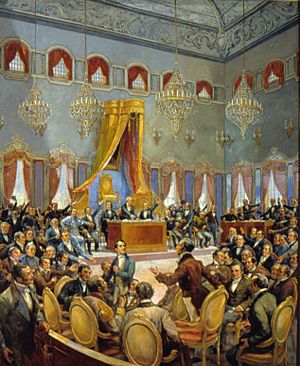Cortes (politics) facts for kids
The Cortes were important political meetings in old monarchies, like a type of early parliament. They were places where leaders discussed and made decisions. The word "Cortes" comes from the Latin word cohors, meaning "court."
These meetings usually involved three main groups, called "Estates":
- The First Estate: This was the clergy, meaning church leaders and religious people.
- The Second Estate: This was the nobility, meaning rich families and lords.
- The Third Estate: This was the "people," represented by important citizens from towns.
The name "Cortes" came from the different "audiences" or meetings where the assembly's work happened. They were also sometimes called "curia," "synod," or "parliament." The Cortes didn't meet regularly. They only gathered when the king decided to call them, usually because of important events or problems.
Contents
Cortes in Portugal
The Cortes in Portugal started from an older advisory group called the Curia Régia. This group helped the king make decisions. The first official meeting of the Curia for the Kingdom of Portugal happened in Coimbra in 1211, during the reign of King Afonso II. Before that, similar meetings happened in the time of the Visigoth monarchy.
How the Cortes Worked
The Cortes in Portugal included church leaders (like bishops), nobles, and representatives from towns. About a hundred towns were allowed to send representatives. For example, in the Cortes of Lisbon in 1502, there were 127 towns represented.
The king would call the Cortes for special meetings. These meetings began with a formal opening. Someone chosen by the king would give a speech explaining why the Cortes were called.

During the meetings, each of the three groups (clergy, nobility, and people) met separately. They would discuss their issues and then present their requests or ideas to the king. The king would then respond to all of them. The king always had the final say. These meetings usually lasted about a month, but they could go on until all matters were discussed.
Sometimes, the Cortes were called "Cortes Gerais" (General Cortes). This happened especially when they met to choose and officially recognize a new king. The main job of the Cortes was to make requests to the king. These requests could be about general problems in the kingdom or specific issues for a certain town or group. If the king agreed to a request, it would become a law.
People were encouraged to share their problems with the king. Their requests were written down in two main ways:
- Particular chapters: These were about specific problems for each town or region.
- General chapters: These were created by all three groups at the start of the meeting. They covered bigger issues for the whole kingdom.
At first, attending the Curia was a duty. But over time, these meetings became more focused on political, economic, and legal problems. The Cortes became truly effective when the "branch of the people" (the Third Estate) started having a permanent place in them. Before that, only the nobility and clergy were close to the king.
It became a tradition that new taxes needed the agreement of the Cortes. This meant the Cortes had power over money matters. They also helped decide who would rule if there was no clear heir to the throne. They also officially recognized and cheered for the new king or queen.
The best time for the Cortes in Portugal was during the 14th and 15th centuries. The very first Cortes meeting was held in Leiria in 1254. The Cortes became less important later on. This happened because kings became less dependent on the nobles. Also, Portugal's overseas trade brought in a lot of wealth. This meant kings didn't need as much money from taxes, so they didn't need to call the Cortes as often.
The Cortes in the Modern Age
Portuguese kings, like João II (who ruled from 1481 to 1495) and Manuel I (who ruled from 1495 to 1521), used the wealth from their empire abroad. This made them less reliant on the Cortes for money. So, they called the Cortes less often. By the time King Sebastião ruled (from 1554 to 1578), the Cortes were almost not important at all.
Cortes in France and the French Revolution
In France, similar meetings were called the Assembly of Estates General. These meetings played a big part in starting the French Revolution in 1789.
France was facing a very serious money crisis. Louis XVI was king, and his finance minister, Jacques Necker, suggested taxing the clergy and nobility. These rich groups refused to pay, which led to protests. Because of this pressure, the king had to call the Estates General. This was a big deal because they hadn't met since 1314!
The Estates General met in May 1789 at the Palace of Versailles. The king hoped to make the Third Estate (the common people) pay the taxes that the clergy and nobility refused. The First and Second Estates tried to stop the Third Estate from making big changes. The representatives of the Third Estate wanted to present the complaints of the people. Because the other two Estates were so stubborn, the Third Estate representatives met separately on June 15, 1789. This action helped kick off the French Revolution.
See also
 In Spanish: Cortes (Antiguo Régimen) para niños
In Spanish: Cortes (Antiguo Régimen) para niños


